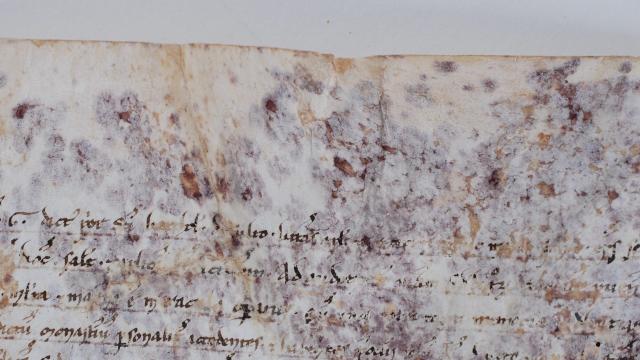Eight hundred years ago, teenager Laurentius Loricatus accidentally killed a man in Italy. He then headed to a cave where he lived for 34 years, whipping himself to atone for his sins. Today, his story lives in the Vatican Secret Archives, on a piece of parchment covered in purple spots.
Image: Luciana Migliore
This kind of damage is common on ancient parchment — but why? What causes it? A team of Italian researchers interested in better understanding the ancient text decided to identify the microbes responsible for the splotching, and applied brand new techniques in order to do so. The researchers probably couldn’t have guessed some of the culprits.
“I found marine microbes,” study author Luciana Migliore from Tor Vergata University in Rome, Italy told Gizmodo. “Where did they come from, in a goat parchment that had been written 800 years ago? This was absolutely surprising.”
The team began by taking already detached tiny squares of parchment both from purple and unstained pieces of the scroll, isolating the DNA and sending it to a lab in Texas for processing. On analysing the sequences, they found 957 kinds of bacteria on the purple spots, and 407 kinds of bacteria on the undamaged spots, with only 140 of the 1224 total species shared between the two. The most common bacteria on the purple spots, surprisingly, were Gammaproteobacteria, mostly the salt-loving ocean kind, according to the paper published today in the journal Scientific Reports

Image: Luciana Migliore
So, how did the splotches form? This parchment came from goat skin, usually preserved with salt brines. The brine could have acted as a culture for the purple microbes to begin sprouting. After salting, the parchment was stretched, shaved and scraped, leaving a salty outside and less salty inside; the collagen in the parchment would serve as the home to the bacterial colonies. The scrolls then could have moved into monasteries, the authors write, where they’d have been exposed to moisture and changing temperatures. Here, the purple bacteria would have flourished.
Other researchers were especially impressed by the paper and its methods. “In my opinion, the paper is well written, the techniques used are state of the art methods,” Guadalupe Pinar from the Universität für Bodenkultur in Austria told Gizmodo. It isn’t usual for folks working in this field to have the “necessary infrastructure and capabilities to perform such analyses”.
As with any study, this one comes with limitations. Pinar pointed out that these methods only rely on a certain subset of DNA sequences, meaning there could be missing data. He pointed out another paper using a different sequencing method better avoided biases, and could do analyses beyond just the bacterial makeup. It’s also important to note you can’t always do a study like this — the authors got lucky that they could analyse pieces of the parchment that had broken off. Normally, they’d have to tear the parchment to do this kind of work.
Still, the paper adds important evidence to support hypotheses of how these spots got there. Researcher Hector Morillas, from the University of the Basque Country in Spain, told Gizmodo he thought it was incredible work — he had no doubts about its methods and conclusions. What’s more, the team has offered new ways of understanding the ageing of these scrolls for the future.
Migliore said: “The most important thing is the application of new techniques that can help to understand the process of these ancient documents.”
